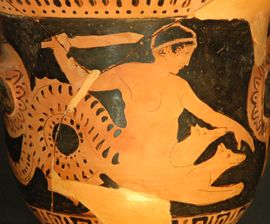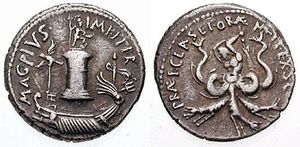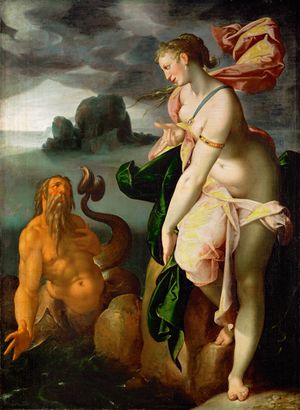سكولا

في الأساطير اليونانية، سيلا أو سكيلا ( /ˈsɪlə/ SIL-ə; باليونانية: Σκύλλα, سكولا، تـُنطق [skýl̚la]؛ إنگليزية: Scylla)[2] كان وحشاً يعيش على أحد جانبي ممر بحري ضيق، مقابل نظيرته خاريبدس. جانبا المضيق كانا على مرمى حجر من بعضهما البعض —أي كانا قريبين لدرجة أن البحارة الذين يحاولون تفادي خاريبدس، كانوا يرتطمون بسيلا، والعكس صحيح.
Scylla made her first appearance in Homer's Odyssey, where Odysseus and his crew encounter her and Charybdis on their travels. Later myth gave her an origin story as a beautiful nymph who gets turned into a monster.[3]
تقليدياً، المضيق تعارف الناس أنه مضيق مسينا بين إيطاليا وصقلية. وقد أصبح التعبير "بين سيلا وخاريبدس" يعني أن المرء بين خطرين، واختيار أياً منهما ضار.
. . . . . . . . . . . . . . . . . . . . . . . . . . . . . . . . . . . . . . . . . . . . . . . . . . . . . . . . . . . . . . . . . . . . . . . . . . . . . . . . . . . . . . . . . . . . . . . . . . . . . . . . . . . . . . . . . . . . . . . . . . . . . . . . . . . . . . . . . . . . . . . . . . . . . . . . . . . . . . . . . . . . . . . .
الأبوة
The parentage of Scylla varies according to author.[4] Homer, Ovid, Apollodorus, Servius, and a scholiast on Plato, all name Crataeis as the mother of Scylla.[5] Neither Homer nor Ovid mentions a father, but Apollodorus says that the father was either Trienus (Triton?) or Phorcus (a variant of Phorkys),[6] similarly the Plato scholiast, perhaps following Apollodorus, gives the father as Tyrrhenus or Phorcus,[7] while Eustathius on Homer, Odyssey 12.85, gives the father as Triton.
الأساطير
According to John Tzetzes[8] and Servius' commentary on the Aeneid,[9] Scylla was a beautiful naiad who was claimed by Poseidon, but the jealous Amphitrite turned her into a monster by poisoning the water of the spring where Scylla would bathe.
A similar story is found in Hyginus,[10] according to whom Scylla was loved by Glaucus, but Glaucus himself was also loved by the goddess sorceress Circe. While Scylla was bathing in the sea, the jealous Circe poured a baleful potion into the sea water which caused Scylla to transform into a frightful monster with four eyes and six long snaky necks equipped with grisly heads, each of which contained three rows of sharp shark's teeth. Her body consisted of 12 tentacle-like legs and a cat's tail, while six dog's heads ringed her waist. In this form, she attacked the ships of passing sailors, seizing one of the crew with each of her heads.
In a late Greek myth, recorded in Eustathius' commentary on Homer and John Tzetzes,[11] Heracles encountered Scylla during a journey to Sicily and slew her. Her father, the sea-god Phorcys, then applied flaming torches to her body and restored her to life.

أوديسة هومر
In Homer's Odyssey XII, Odysseus is advised by Circe to sail closer to Scylla, for Charybdis could drown his whole ship: "Hug Scylla's crag—sail on past her—top speed! Better by far to lose six men and keep your ship than lose your entire crew."[12] She also tells Odysseus to ask Scylla's mother, the river nymph Crataeis, to prevent Scylla from pouncing more than once. Odysseus successfully navigates the strait, but when he and his crew are momentarily distracted by Charybdis, Scylla snatches six sailors off the deck and devours them alive.
|
تحولات أوڤيد
According to Ovid,[14] the fisherman-turned-sea god Glaucus falls in love with the beautiful Scylla, but she is repulsed by his piscine form and flees to a promontory where he cannot follow. When Glaucus goes to Circe to request a love potion that will win Scylla's affections, the enchantress herself becomes enamored with him. Meeting with no success, Circe becomes hatefully jealous of her rival and therefore prepares a vial of poison and pours it into the sea pool where Scylla regularly bathed, transforming her into a thing of terror even to herself.
|
The story was later adapted into a five-act tragic opera, Scylla et Glaucus (1746), by the French composer Jean-Marie Leclair.
اللوحات

At the Carolingian abbey of Corvey in Westphalia, a unique ninth-century wall painting depicts, among other things, Odysseus' fight with Scylla,[16] an illustration not noted elsewhere in medieval arts.[17]
الهامش
- ^ Ogden (2013), p. 132.
- ^ بالإنگليزية الوسيطة سكيلّى ( /ˈsɪliː/، تعكس باليونانية: Σκύλλη)، لم تعد مستعملة.
- ^ Ogden (2013), pp. 130–131.
- ^ For discussions of the parentage of Scylla, see Fowler, p. 32, Ogden, pp. 134–135; Gantz, pp. 731–732; and Frazer's note to Apollodorus, E7.20.
- ^ Homer, Odyssey 12.124–125; Ovid, Metamorphoses 13.749; Apollodorus, E7.20; Servius on Virgil Aeneid 3.420; schol. on Plato, Republic 9.588c.
- ^ Ogden, p. 135; Gantz, p. 731.
- ^ Fowler, p. 32
- ^ John Tzetzes, On Lycophron 45
- ^ Servius on Aeneid III. 420.
- ^ Hyginus, Fabulae, 199
- ^ On Lycophron 45
- ^ Robert Fagles, The Odyssey 1996, XII.119ff.
- ^ Fagles 1996 XII.275–79.
- ^ Ovid, Metamorphoses xiii. 732ff., 905; xiv. 40ff.; translation by Nicholas Rowe and Samuel Garth is in GoogleBooks
- ^ Ovid, Metamorphoses xiv.51–2
- ^ Available in Wikimedia
- ^ UNESCO: Corvey Abbey and Castle
المراجع
- Apollodorus, Apollodorus, The Library, with an English Translation by Sir James George Frazer, F.B.A., F.R.S. in 2 Volumes. Cambridge, MA, Harvard University Press; London, William Heinemann Ltd. 1921. Online version at the Perseus Digital Library.
- Apollonius of Rhodes, Apollonius Rhodius: the Argonautica, translated by Robert Cooper Seaton, W. Heinemann, 1912. Internet Archive
- Campbell, David A., Greek Lyric III: Stesichorus, Ibycus, Simonides, and Others, Harvard University Press, 1991. ISBN 978-0674995253.
- Fowler, R. L., Early Greek Mythography: Volume 2: Commentary, Oxford University Press, 2013. ISBN 978-0198147411.
- Gantz, Timothy, Early Greek Myth: A Guide to Literary and Artistic Sources, Johns Hopkins University Press, 1996, Two volumes: ISBN 978-0-8018-5360-9 (Vol. 1), ISBN 978-0-8018-5362-3 (Vol. 2).
- Hanfmann, George M. A., "The Scylla of Corvey and Her Ancestors" Dumbarton Oaks Papers 41 "Studies on Art and Archeology in Honor of Ernst Kitzinger on His Seventy-Fifth Birthday" (1987), pp. 249–260. Hanfman assembles Classical and Christian literary and visual testimony of Scylla, from Mesopotamian origins to his ostensible subject, a ninth-century wall painting at Corvey Abbey.
- Hyginus, Gaius Julius, The Myths of Hyginus. Edited and translated by Mary A. Grant, Lawrence: University of Kansas Press, 1960.
- Most, G.W. (2007), Hesiod: The Shield, Catalogue, Other Fragments, Loeb Classical Library, no. 503, Cambridge, MA, ISBN 978-0-674-99623-6. English translation with facing Greek text; takes much recent scholarship into consideration.
- Ogden, Daniel (2013). Drakon: Dragon Myth and Serpent Cult in the Greek and Roman Worlds. Oxford University Press. ISBN 9780199557325.
{{cite book}}: Invalid|ref=harv(help) - Stesichorus, in Greek Lyric, Volume III: Stesichorus, Ibycus, Simonides, and Others. Edited and translated by David A. Campbell. Loeb Classical Library 476. Cambridge, MA: Harvard University Press, 1991.
- Virgil, Aeneid. Translated by Frederick Ahl: Oxford University Press, 2007.
وصلات خارجية
- Theoi Project, Skylla references in classical literature and ancient art.
- Images of Scylla on Classical artefacts
- Articles containing Greek-language text
- Articles with hatnote templates targeting a nonexistent page
- Articles containing إنگليزية-language text
- Pages using Lang-xx templates
- مخلوقات أسطورية يونانية
- وحوش في الأساطير اليونانية
- كلاب أسطورية
- هجائن أسطورية
- Female legendary creatures
- Metamorphoses in Greek mythology
- Nereids
- Sea monsters


